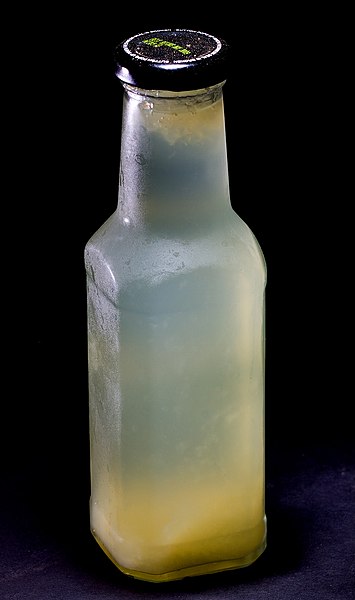There has been quite a fuss surrounding taiwanese drinks back then in 2011 - you hear all those 'completely artificial' drinks from taiwan and many of us stopped buying drinks from these taiwanese outlets. Whereas it is true that these drinks are artificial, the health impact they had in human is debatable.
The case was that a supplier of clouding agent added a plasticizer called Bis(2-ethylhexyl)phthalate also known as DEHP into its product.
Clouding agent
Clouding agent is a type of food additive which causes the drink to become cloudy.
This cloudy lemonade is an example of what a drink would
look like if a clouding agent is added to it[1]
Typical clouding agent contains gum arabic, palm oil as well as citrus extracts. By nature of its palm oil, it is easy to spoil and gives a rancid taste when spoiled. There, they noted that DEHP, when added to it instead of palm oil, will produce a very nice clouding effect with little chance of spoiling. All these contribute to a better product, except... that DEHP is an antiandrogen (That is, it interferes with male sex hormone production and/or the effect of male sex hormone).
And then, as usual, with the ultra-sensitive investigations available, suddenly we are worried about the presence of DEHP everywhere - taiwanese drinks included. But when it comes to a drug...
There are also other plasticizers similar to DEHP and their toxicity are also similar.
Augmentin
Augmentin is a very common penicillin-type antibiotics. Arguably, it is the most commonly prescribed antibiotic both in in-patient and out-patient settings - mostly because of its broad spectrum (the ability to kill many different kinds of bacteria).
The tablet of it contained 2.7 ppm of DIDP, 1.1ppm of DEHP and 3.5ppm of DINP.
The powder for syrup reconstitution contained 88ppm of DIDP and 1.4ppm of DINP.
The maximum allowable intake level of DIDP is 2200 microgram per day[2]. 2.7ppm is 2.7mg/kg = 2.7microgram/g. An augmentin 375mg tablet is about 500mg in weight. by proportion, it contains about 1.35 microgram of DIDP. A full course of augmentin thus contain 28.35 micrograms of DIDP (1.35 x 3 times per day x 7 days). The daily dose is about 0.18% of the maximum allowable intake level. One has to take a 500x overdose of augmentin tablet in order to see a reproductive effect of DIDP. To be honest, if one takes a 500x overdose augmentin I would worry about the brain of the patient more than the antiandrogen effect of DIDP/DEHP/DINP...
For the powder, it has a vastly higher amount of DIDP at 88ppm. 88ppm is 88mg/kg = 88 microgram per gram. The 457mg/5ml syrup contain around 1g of powder for 5ml of syrup. Thus, there is 88 microgram of DIDP in 5ml of syrup. A full course thus contain 1232 microgram of DIDP. The daily dosage, which is 176 micrograms, represents 8% of the maximum allowable intake level.
And then they take away all the oral augmentin available from the clinics and hospitals. Compare the risk of patient requiring the use of second line antibiotics (which are more expensive / had more side effects / had narrower spectrum / less suitable) with these small risks of anti-androgenic effect from plasticizers... well, not that the ban is incorrect, but the negative impact is so much worse than the woes it caused.
For the matter, the maximum allowable dose level of DEHP is 418ug/day for adults, 58ug/day for children and 20ug/day for neonates; and none was defined for DINP. One can try to do the mathematics, but it is exceedingly unlikely for anybody to become affected by the dose level available in the syrup or the tablet.
You get the idea.
[1] The picture taken was from a natural cloudy lemonade, which is a mixture of water, sugar and lemon juice. The clouding effect is natural and is not due to a clouding agent. This photo is (C) 2009 JJ Harrison, used per CC-BY-SA 2.5 license. (Further information available from Wikipedia)
[2] http://oehha.ca.gov/prop65/CRNR_notices/pdf_zip/DIDPMADLfinalrisk042310.pdf

No comments:
Post a Comment